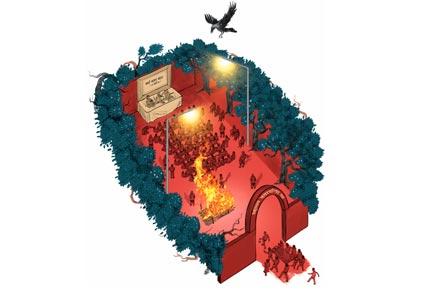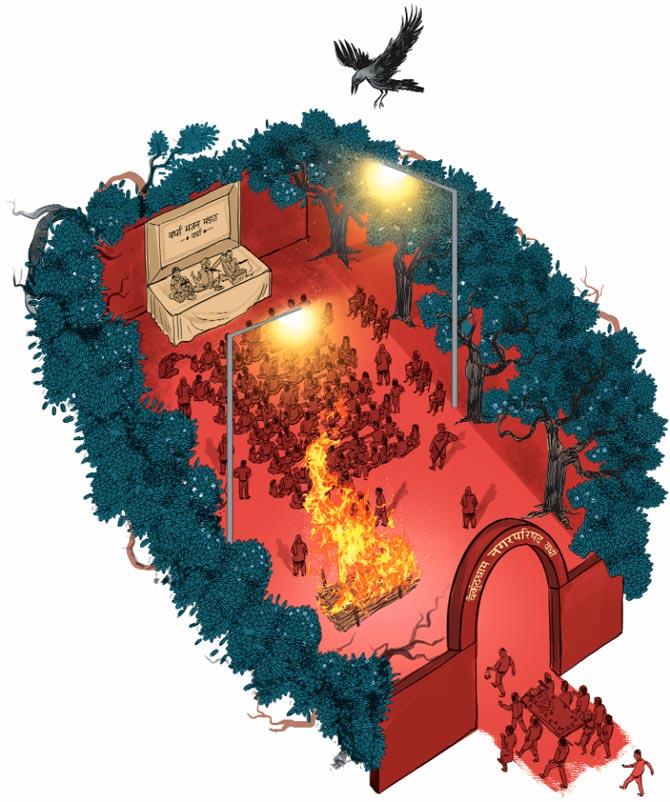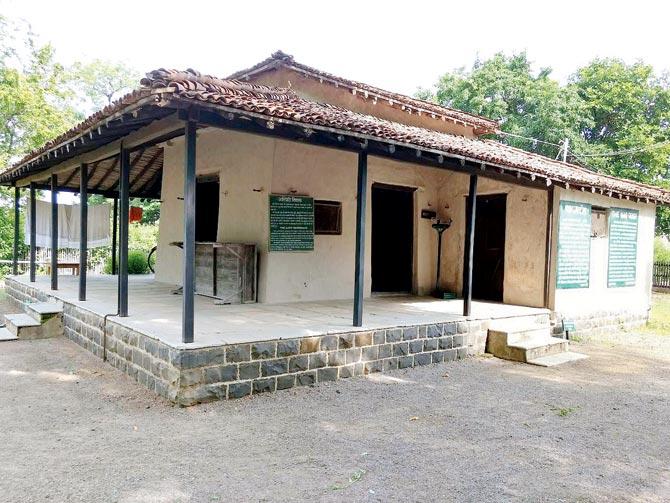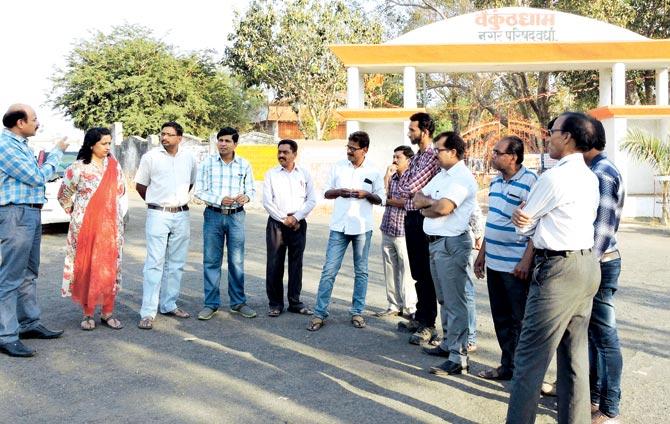While the rest of India goes ballistic with colour and music, Wardha's Hindu crematorium will come alive in the dead of night to host a unique annual Holi festival that challenges superstition


Illustration/Uday Mohite
 The fear of ghosts, thieves and serpents dominated the formative years of Mohandas Karamchand Gandhi. His autobiography speaks of his fear of sleeping without a light, and how he came to terms with irrational associations. The Mahatma's experiments with truth, still recalled as an epoch-making acceptance of the fear of the unknown, is at the core of his great grandson Tushar Gandhi's exploratory presentation, Gandhi: Yesterday, Today, Tomorrow, at the 21st Lokjagar Smashan Holikotsav. The one-of-its-kind, full moon night event is held every year at a crematorium in Wardha city, 81 km from from Nagpur.
The fear of ghosts, thieves and serpents dominated the formative years of Mohandas Karamchand Gandhi. His autobiography speaks of his fear of sleeping without a light, and how he came to terms with irrational associations. The Mahatma's experiments with truth, still recalled as an epoch-making acceptance of the fear of the unknown, is at the core of his great grandson Tushar Gandhi's exploratory presentation, Gandhi: Yesterday, Today, Tomorrow, at the 21st Lokjagar Smashan Holikotsav. The one-of-its-kind, full moon night event is held every year at a crematorium in Wardha city, 81 km from from Nagpur.
ADVERTISEMENT
Aimed at humanising the mystical and feared cemetery or cremation ground, it was initiated in 1997 by a handful of anti-superstition volunteers who felt that a fun get-together at Wardha's Hindu crematorium (lining the Muslim and Christian burial grounds) would help bust the popular myth about ghosts seizing unsuspecting frequenters on new moon or full moon nights.

The iconic Bapu Kuti where Mahatma Gandhi stayed in Sevagram. Pics/Wikicommons
What was once a small-scale assembly of 15-odd Andhashraddha Nirmulan Samiti volunteers lighting the traditional Holi pyre is now a non-conformist, all-faith Holi celebration attended by thousands. Women, traditionally allowed inside crematorium only after death, are particularly encouraged to attend, as are children and senior citizens in what many describe as Wardha's amphitheatre.
Discarding both rang and woodfire — central to Holi celebrations but viewed here as pollutants — Smashan Holi draws its energy from the arts. Every year, a new performing art holds centrestage — short skits, poetry recitation, keertan and devotional songs, stand-up comedy, magician tricks, mimicry and formal presentations, like the one Tushar Gandhi is scheduled to deliver today (March 12).

Gandhi and his personal secretary Mahadev Desai at Sevagram, 8 km from Wardha
Last year witnessed the first ever ghazal concert rendered here by Mumbai-based Bhimrao Panchale, who called it "a spiritual high to sing for three hours in a smashan under a fully-lit March sky." Two children's birthday celebrations followed the performance, which made way for an intermission of collective pastry eating. Book and CD releases, felicitation of state-level awardees and honouring meritorious Class X students are miscellaneous features added each
As the festival progresses late into the night, the stage is lit with halogen lamps while the foreground beams with pyres of departed souls. The pyres did shock the audience in the initial years, but slowly, the festival and the coinciding cremations became an accepted reality. As co-founder Sanjay Ingle Tigaonkar, recalls, the grieving families that come for the last rites often join the fest. None have ever complained about disturbance or disrespect. The purpose behind the festival is fully served as "we play our parts well, leaving no role for the ghosts." One year, the activists showed the 'science' behind the barefoot walk on fire, which many sadhus credit to supernatural powers. The lesson in physics was educational and also surreally entertaining in a place where bodies are set afire every day.

Anti-superstition activists from Wardha assemble at the gate of Wardha Hindu crematorium to prepare for this year's Smashan Holi
Wardha's crematorium Holi has become a vantage point for the anti-superstition campaign in the city and 100 adjoining villages. Patrons invariably become volunteers willing to do their bit — either by sprucing up the venue, bringing snacks for guests, or helping in the year-long operations to expose deceptive godmen and their exploitative practices. Often, they send tip-offs about pseudo-scientific claims made by bogus seers and fortune-tellers. As theatre person and filmmaker Harish Ethape, among the first few to father the smashan concept, puts it, "Our Holi has given birth to a large family of friends beyond Wardha. We dip into our personal savings (last year the amount stood at R1 lakh). No fancy advertising, just simple publicity through handbills and word of mouth, allows is to retain our irreverent vibe."
Smashan Holikotsav rests on stakeholders from strikingly dissimilar professions. Constable Yogita Masram (35) has been singing every year since she was a teenager, much before she joined the police and was handed Holi bandobast duty. This year, she intends to present a skit on e-frauds with her colleagues from the cyber cell. Prashant Uttarmare (42), provider of the carpets, mattresses and stage backdrop is a regular attendee. He helps dismantle the bichayat props at an unearthly hour. None else but Wardha's municipal council chief Atul Tarale (42) has supported the event by giving the annual permission needed according to civic administration norms.
Mukesh Lutade (36), a khadi dyeing expert working in Wardha's iconic Magan Sangrahalya which promotes cottage industry products, has been key in popularising the late night festival among foreign and Indian tourists who arrive in Wardha. It is another story that the festival has its own homegrown student viewers. For instance, primary school teacher Pankaj Wanjare, who was an adolescent when the festival started, arrives with his students and their families in tow. Professor Sheikh Hasham, a retired political science lecturer, comes with his proteges. He specialises in a presentation on Saint Tukdoji Maharaj's Gram Geeta — an epic on village life, which labels human upliftment as the best form of devotion.
There is a reason why the too-good-to-be true Smashan Holi has wide appeal in Wardha — a city that has been the epicentre of several progressive national movements ever since the Mahatma chose a village on its outskirts as his residence (1936) and called it Sevagram. Sevagram became home to India's first rural medical college offering affordable healthcare to the underprivileged. As urban governance consultant Shrikant Barhate, who shuttles between Wardha and Washington, says, "It's not surprising that an idea like this took off in a city blessed with Gandhiji and Acharya Vinoba Bhave's company. It's a city that has never witnessed communal riots, and was home to several agrarian agitations. It's surprising why the idea did not catch on in other 'forward' urban parts of the country."
Mumbaikar Tushar Gandhi agrees. "Gandhiji had said if my faith burns bright, I will speak from my funeral pyre and what is more, from beyond it too. The Wardha Holi model burns bright and urges all of us to think of new ways about space at a time when most festivals are getting increasingly commercialised."
Sumedha Raikar-Mhatre is a culture columnist in search of the sub-text. You can reach her at sumedha.raikar@gmail.com
 Subscribe today by clicking the link and stay updated with the latest news!" Click here!
Subscribe today by clicking the link and stay updated with the latest news!" Click here!







